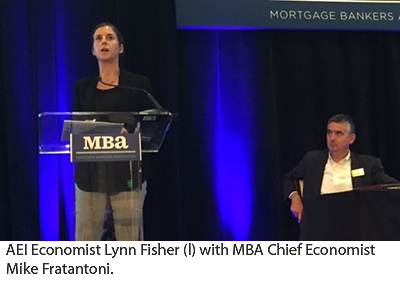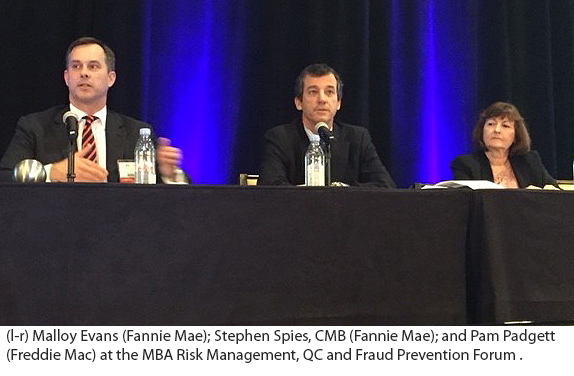
Shift to Purchase Market Brings New Mortgage Risks
LOS ANGELES–With the slow, but definite shift from a refinance market to a purchase market, competition for borrowers is at unprecedented highs. And with that, says economist Lynn Fisher, comes a new set of risk for mortgage servicers.
 “Home sales have flattened over the past year,” Fisher said here at the Mortgage Bankers Association’s Risk Management, Quality Assurance and Fraud Prevention Forum. “But prices are going up. Inventories continue to remain low, which is spurring competition for homes–and a potential increase in credit risk.”
“Home sales have flattened over the past year,” Fisher said here at the Mortgage Bankers Association’s Risk Management, Quality Assurance and Fraud Prevention Forum. “But prices are going up. Inventories continue to remain low, which is spurring competition for homes–and a potential increase in credit risk.”
AEI reported more than six million purchase transactions for the four quarters ending in June, of which 60 percent (4.2 million) was institutionally financed, a trend that has steadily increased over the past several years. While shares picked up for Fannie Mae, Freddie Mac, FHA and VA, most of the increase has come from the private market.
But the increase in agency purchase loans has also seen an increase in agency risk. The AEI National Mortgage Risk Index found an 6.4 percent increase in the stressed default rate for FHA loans, to 28 percent (from 21.4 percent), while VA (12 percent), Fannie Mae (7.5 percent) and Freddie Mac (6.6 percent) only saw slight increases; the composite stress default rate stood at just under 13 percent.
Furthermore, said Fisher, Resident Scholar and Co-Director of the AEI Center on Housing Markets and Finance with the American Enterprise Institute, Washington, D.C., and former economists with MBA, “most of the new risk comes from first-time homebuyers and reflects an increase in debt-income ratios.”
Representatives from Fannie Mae and Freddie Mac said the shift in markets have caused them to make adjustments to their business models.
“We’ve seen a real improvement in data quality,” said Malloy Evans, Vice President of Single-Family Credit Policy and Risk Management with Fannie Mae, Washington, D.C. “Our ability to make good judgment on credit depends on our ability to receive good data.”
 Evans said Fannie Mae remains concerned about fraud risk. “There’s a different fraud risk out there today,” he noted. “We’re starting to see loans that once again are stretching the reaches of our credit box. Our focus is to improve the process. We are always looking at ways to continuously improve our processes, and the results–a drop in cumulative default rates, better quality, better data–speak for themselves.”
Evans said Fannie Mae remains concerned about fraud risk. “There’s a different fraud risk out there today,” he noted. “We’re starting to see loans that once again are stretching the reaches of our credit box. Our focus is to improve the process. We are always looking at ways to continuously improve our processes, and the results–a drop in cumulative default rates, better quality, better data–speak for themselves.”
Stephen W. Spies, CMB, Vice President of Loan Quality with Fannie Mae, said 10 years after the financial crisis, the loan quality picture looks “great.”
“From high single-digits to less than .5 percent, we now have ‘fail-safe’ type limits and triggers,” Spies said. “Repurchases are at an all-time low, which was not what we were about. We have rigorous standards and strong accountability, with clear defect taxonomy and extensive quality control reporting.”
“I’m really proud of the transparency we’ve created,” Spies added. “Our Boot Camps are a testament to that. We now have a strong culture of quality and third-party risk is proactively managed.” He said the company’s Loan Quality Connect system enables Fannie Mae to partner with lenders on quality management in real time.
But Spies cautioned that this is the time to be wary. “We’re entering the riskiest part of the cycle,” he said. “Volumes are down and lots of lenders are chasing lots of equity. Fraud is emerging, but it’s a good sign that lenders are self-reporting. They recognize that as a community that this is important and that we can improve.”
Spies said the digital mortgage offers new opportunities and challenges for quality control. “QC can’t be sacrificed in the name of innovation,” he said. “Don’t do QC for us; do it for yourselves.”
Pam Padgett, Vice President of Quality Control with Freddie Mac, McLean, Va., said her company is focusing on the borrower of the future. “Our nation is becoming a lot more diverse, with diverse ideas about homeownership,” she said. “It’s creating challenges in the gig economy, where people have non-traditional documentation but the same expectations to achieve homeownership.”
Part of that has involved revamping Freddie Mac’s Loan Advisor Suite; for example, Freddie Mac has invited clients to run both its Loan Product Advisor and Fannie Mae’s Desktop Underwriter, so that lenders can see all available options. Freddie Mac is also automating validation of income and asses b leveraging data from third-party sources, such as Finicity, Equifax and LoanBeam. “This speeds the process for borrowers and provides independent, verifiable data,” Padgett said.
Padgett said she was optimistic about automation as a QC/fraud prevention tool. “But it’s not a foolproof process,” she said. “We have to anticipate where–and how–automated processes can be manipulated. Testing, validating and confirming data accuracy, its source and its path remains necessary.”
Padgett said Freddie Mac is reimagining its QC workflow and processes. “We’re leveraging automation to replace human intervention on non-underwriting activities,” she said.
Padgett noted while loan quality has significantly improved, errors persist, particularly in income calculations, “which has been our most common error for years. Underwriters today more likely than not grew up in an AUS world and haven’t been trained to look for this. We have to ensure that our training catches these red flags and give staff the ability to detect and prevent fraud.”
